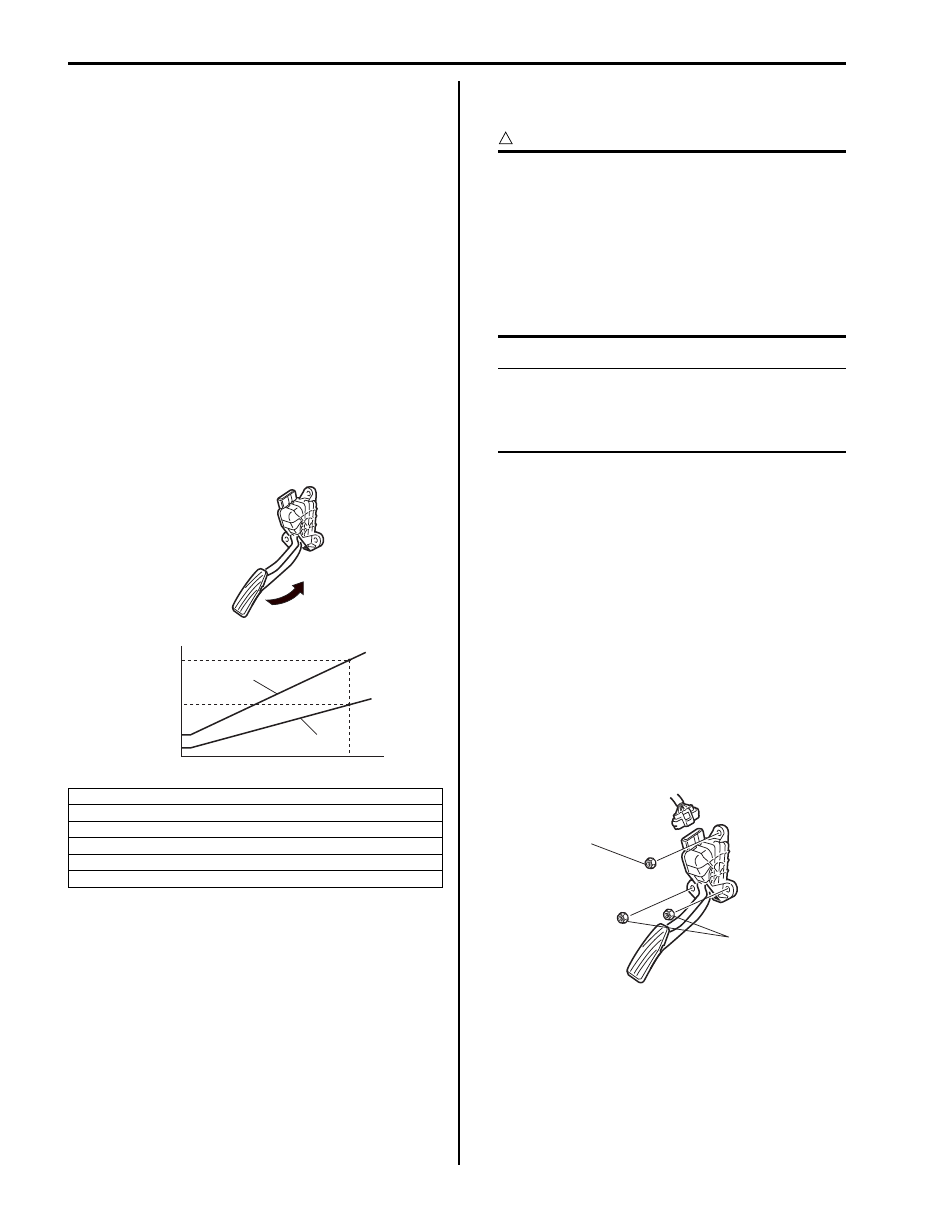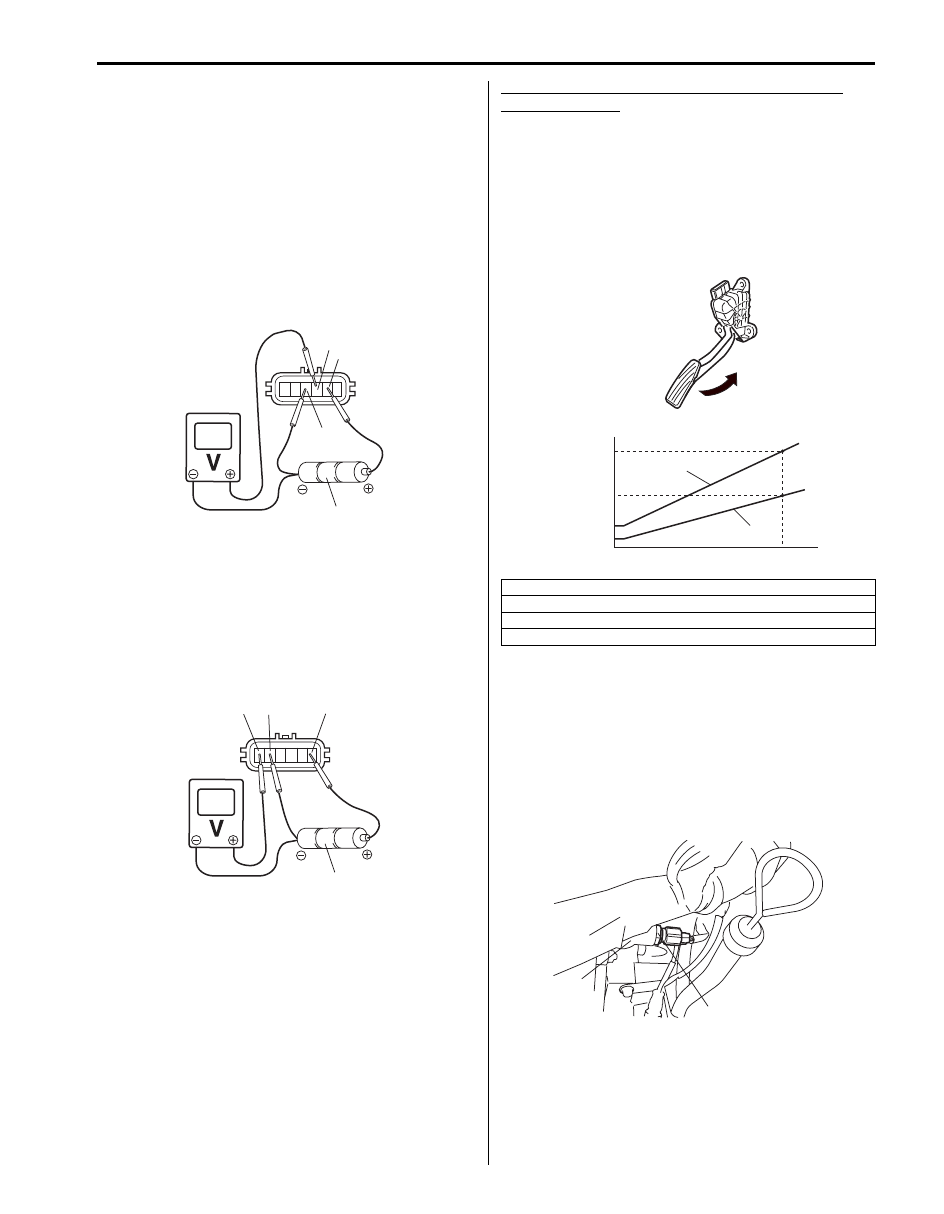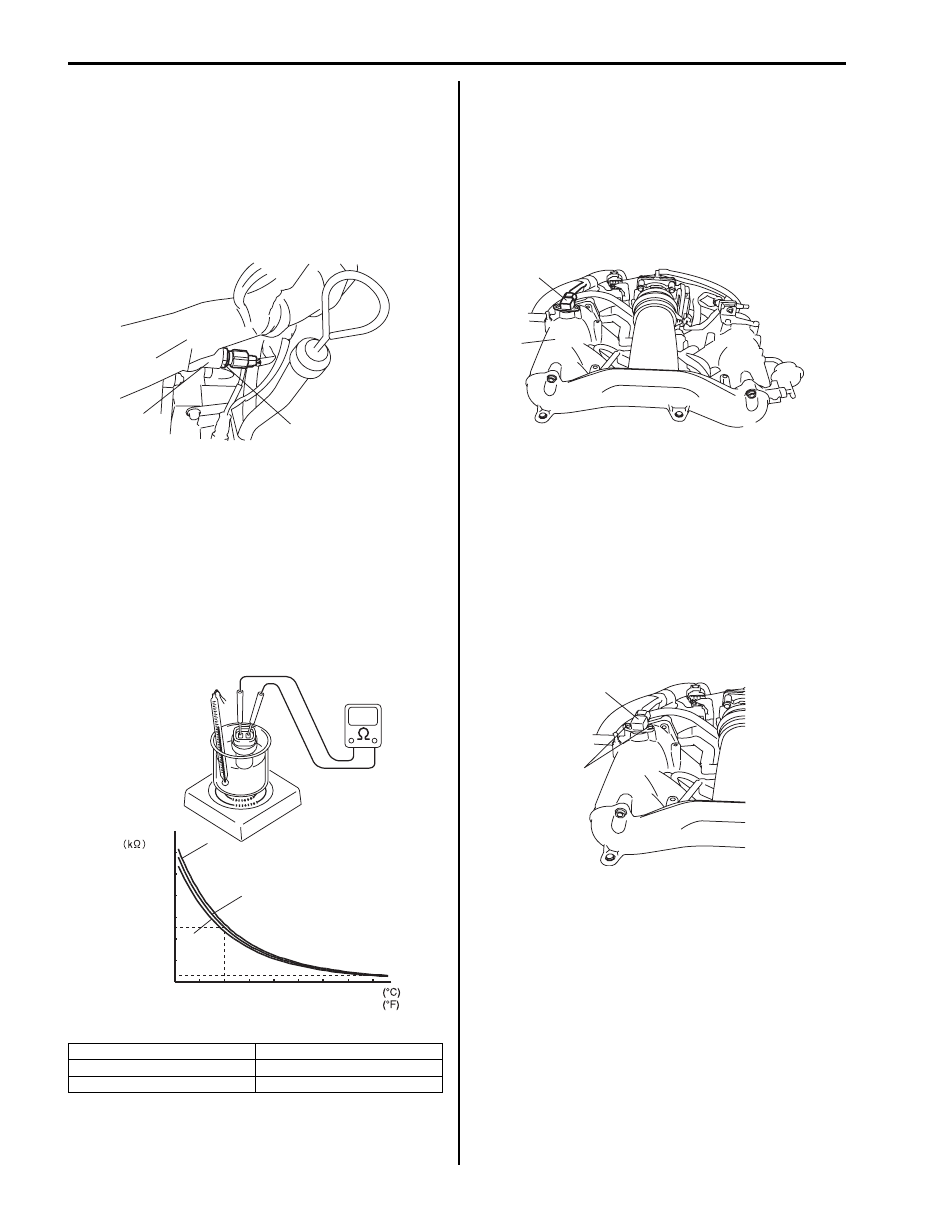Suzuki Grand Vitara JB627. Manual — part 77

1C-6 Engine Electrical Devices:
Accelerator Pedal Position (APP) Sensor
Assembly On-Vehicle Inspection
S6JB0B1306006
1) Check that accelerator pedal position (APP) sensor
assembly has been mounted to vehicle body
properly (no pinched floor carpet, etc.).
If mounting is not properly, reinstall accelerator pedal
position (APP) sensor assembly properly referring to
“Accelerator Pedal Position (APP) Sensor Assembly
Removal and Installation”.
2) Connect scan tool to DLC with ignition switch turned
OFF.
3) Turn ON ignition switch and select “Data List” mode
on scan tool.
4) Check that accelerator pedal position sensor voltage
varies as the following graph.
If sensor voltage is out of specified value or does not
vary linearly as the following graph, check
accelerator pedal position (APP) sensor assembly
referring to “Accelerator Pedal Position (APP)
Sensor Assembly Inspection”.
Accelerator Pedal Position (APP) Sensor
Assembly Removal and Installation
S6JB0B1306007
CAUTION
!
• Do not expose accelerator pedal position
(APP) sensor assembly to excessive shock
like a dropping it. If accelerator pedal
position (APP) sensor assembly has been
exposed to excessive shock, it should be
replaced.
• Be careful not to expose sensor section of
accelerator pedal position (APP) sensor
assembly to water.
NOTE
After replacing accelerator pedal position
(APP) sensor assembly, perform calibration
of throttle valve referring to “Electric Throttle
Body System Calibration”.
Removal
1) Disconnect negative cable at battery.
2) Disconnect connector from accelerator pedal
position (APP) sensor assembly.
3) Remove accelerator pedal position (APP) sensor
assembly from its bracket.
Installation
Reverse removal procedure for installation noting the
following.
• Tighten accelerator pedal position (APP) sensor
assembly upper nut (1) first and then lower nuts (2) to
specified torque.
Tightening torque
Accelerator pedal position (APP) sensor assembly
nut (a): 6.0 N·m (0.6 kgf-m, 4.5 lb-ft)
• If APP sensor assembly bracket is removed, tighten
its mounting nuts to specified torque.
Tightening torque
APP sensor assembly bracket nut (a): 6.0 N·m (
0.6 kgf-m, 4.3 lb-ft)
• Connect connector to accelerator pedal position
(APP) sensor assembly securely.
[A]: Accelerator pedal position (APP) sensor (main) voltage
[B]: Accelerator pedal position (APP) sensor (sub) voltage
[C]: Sensor output voltage
[D]: Idle position of accelerator pedal
[E]: Full depressed position of accelerator pedal
[F]: Pedal stroke
[C]
[B]
[D]
[F]
[E]
[A]
1.74 - 2.17 V
0.65 - 0.82 V
3.50 - 4.27 V
0.30 - 0.44 V
I5JB0A130018-05
1, (a)
2, (a)
I5JB0A130036-01

Engine Electrical Devices: 1C-7
Accelerator Pedal Position (APP) Sensor
Assembly Inspection
S6JB0B1306008
Check accelerator pedal position (APP) sensor (main
and sub) output voltage as following steps.
1) For accelerator pedal position (APP) sensor (main),
arrange 3 new 1.5 V batteries (1) in series (check
that total voltage is 4.7 – 5.0 V) and connect its
positive terminal to “Vin 1” terminal (2) and negative
terminal to “Ground 1” terminal (3) of sensor. Then
using voltmeter, connect positive terminal to “Vout 1”
terminal (4) of sensor and negative terminal to
battery.
2) For accelerator pedal position (APP) sensor (sub),
arrange 3 new 1.5 V batteries (1) in series (check
that total voltage is 4.7 – 5.0 V) and connect its
positive terminal to “Vin 2” terminal (2) and negative
terminal to “Ground 2” terminal (3) of sensor. Then
using voltmeter, connect positive terminal to “Vout 2”
terminal (4) of sensor and negative terminal to
battery.
3) Measure output voltage variation while accelerator
pedal is no depressed and fully depressed as
following specification.
If sensor voltage is out of specified value or does not
vary linearly as the following graph, replace accelerator
pedal position (APP) sensor assembly.
Accelerator pedal position (APP) sensor output
voltage variation
Accelerator pedal position (APP) sensor (main)
output voltage variation [A]: 0.82 – 3.50 V at
minimum variation, varying according to depressed
extent of accelerator pedal
Accelerator pedal position (APP) sensor (sub)
output voltage variation [B]: 0.44 – 1.74 V at
minimum variation, varying according to depressed
extent of accelerator pedal
Engine Coolant Temperature (ECT) Sensor
Removal and Installation
S6JB0B1306009
Removal
1) Disconnect negative cable from battery.
2) Drain cooling system.
3) Disconnect coupler from ECT sensor (1).
4) Remove ECT sensor (1) from water outlet cap (2).
1
2
3
4
I5JB0A130019-02
1
2
3
4
I5JB0A130020-02
[C]: Sensor output voltage
[D]: Idle position of accelerator pedal
[E]: Fully depressed position of accelerator pedal
[F]: Pedal stroke
[C]
[B]
[D]
[F]
[E]
[A]
1.74 - 2.17 V
0.65 - 0.82 V
3.50 - 4.27 V
0.30 - 0.44 V
I5JB0A130021-05
1
2
I6JB01130014-01

1C-8 Engine Electrical Devices:
Installation
Reverse removal procedure noting the following.
• Clean mating surfaces of sensor and water outlet cap
(1).
• Use new O-ring.
• Tighten ECT sensor to specified torque.
Tightening torque
ECT sensor (a): 12 N·m (1.2 kgf-m, 8.5 lb-ft)
• Connect coupler to sensor securely.
• Refill cooling system.
Engine Coolant Temperature (ECT) Sensor
Inspection
S6JB0B1306010
Immerse temperature sensing part of ECT sensor in
water and measure resistance between sensor terminals
while heating water gradually. If measured resistance
doesn’t show characteristics as shown in the figure,
replace ECT sensor.
Manifold Absolute Pressure (MAP) Sensor
Removal and Installation (If Equipped)
S6JB0B1306011
Removal
1) Disconnect negative cable at battery.
2) Disconnect connector from manifold absolute
pressure sensor (1).
3) Remove manifold absolute pressure sensor (1) from
intake manifold (2).
Installation
1) Confirm that vacuum passage on intake manifold is
free from clog.
2) Apply engine oil to O-ring of manifold absolute
pressure sensor.
3) Install manifold absolute pressure sensor (1) onto
intake manifold.
4) Tighten MAP sensor bolt (2) to specified torque.
Tightening torque
MAP sensor bolt (a): 5 N·m (0.5 kgf-m, 3.5 lb-ft)
5) Connect connector to manifold absolute pressure
sensor securely.
[A]: Lower limit
[D]: Resistance
[B]: Normal
[E]: Temperature
[C]: Upper limit
(a)
1
I6JB01130015-02
20
0
68
32
104
140
176
40
60
80
[E]
2.29 - 2.62
0.309 - 0.331
[A]
[B]
[C]
[D]
I5JB0A130037-01
1
2
I6JB01130016-01
1
2, (a)
I6JB0B130001-01

Engine Electrical Devices: 1C-9
Manifold Absolute Pressure (MAP) Sensor
Inspection
S6JB0B1306012
1) Check sensor O-ring (1) for damage and
deterioration. Replace as necessary.
2) Arrange new three 1.5 V batteries (2) in series and
connect its positive terminal to “Vin” terminal and
negative terminal to “Ground” terminal. Then, check
voltage between “Vout” and “Ground”. Also, check if
voltage reduces when vacuum is slowly applied up
to 400 mmHg by using vacuum pump (3). If check
result is not satisfactory, replace manifold absolute
pressure sensor (1).
CAUTION
!
As connection to wrong terminal will cause
damage to manifold absolute pressure
sensor, make absolutely sure to connect
properly as shown in the figure.
Manifold absolute pressure output voltage (“Vin”
voltage: 4.7 – 5.5 V, ambient temp. 20 – 30
°C (68 –
86
°F))
Air Fuel Ratio (A/F) Sensor On-Vehicle
Inspection
S6JB0B1306013
WARNING
!
To avoid danger of being burned, do not
touch exhaust system when system is hot.
Sensor inspection should be performed
when system is cool.
Heater
1) Disconnect A/F sensor connector.
2) Using ohmmeter, measure resistance of Sensor
heater between terminals “V
B
” and “GND” at sensor
connector. If found faulty, replace A/F sensor.
NOTE
Temperature of sensor affects resistance
value largely. Make sure that sensor heater is
at correct temperature.
A/F sensor heater resistance
2 – 3
Ω at 20 °C (68 °F)
Viewed from terminal side
3) Connect A/F sensor connector securely.
Circuit Insulation Check
1) Disconnect connector from A/F sensor.
2) Using ohmmeter, check circuit insulation of A/F
sensor. If faulty is found, replace A/F sensor.
• Between each heater terminal (1) and other than
heater terminals (2).
Viewed from terminal side
Altitude
(Reference)
Barometric pressure
Output
voltage
(ft (m))
(mmHg)
(kPa)
(V)
0 – 2000
(0 – 610)
760 – 707
100 – 94 3.3 – 4.3
2001 – 5000
(611 – 1524)
Under 707, Over
634
94 – 85 3.0 – 4.1
5001 – 8000
(1525 – 2438)
Under 634, Over
567
85 – 76 2.7 – 3.7
8001 – 10000
(2439 – 3048)
Under 567, Over
526
76 – 70 2.5 – 3.3
I1SQ01130005-01
IYSQ01130006-01
“GND”
“V
B
”
I5JB0A130001-02
1
2
I6JB01130034-01

Нет комментариевНе стесняйтесь поделиться с нами вашим ценным мнением.
Текст